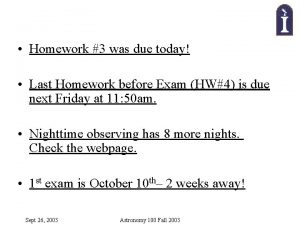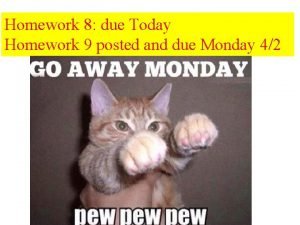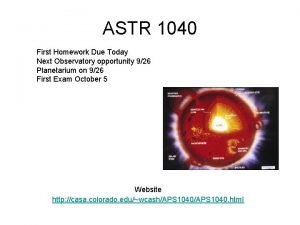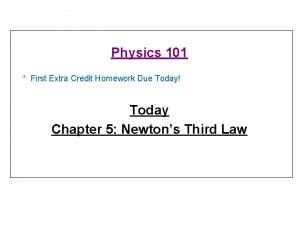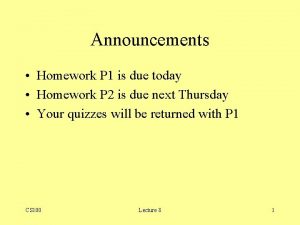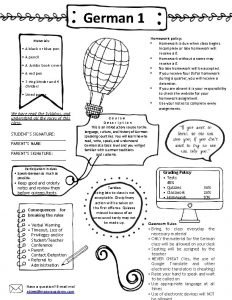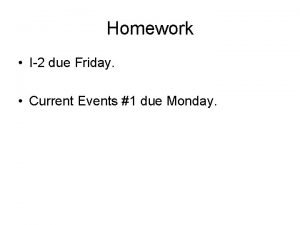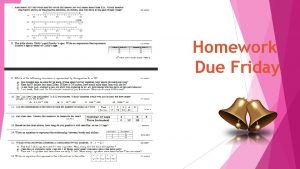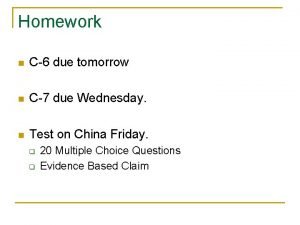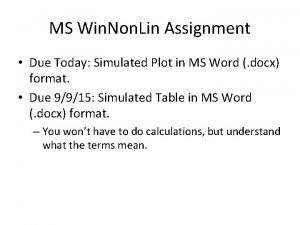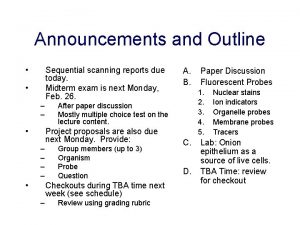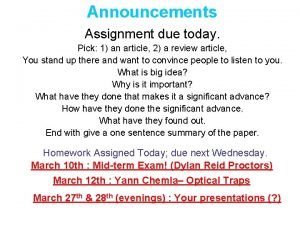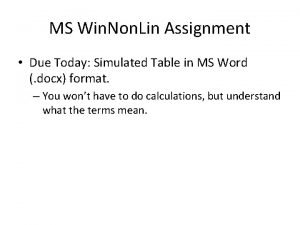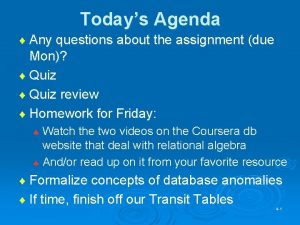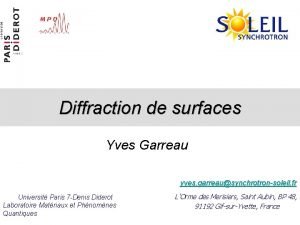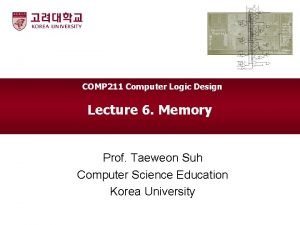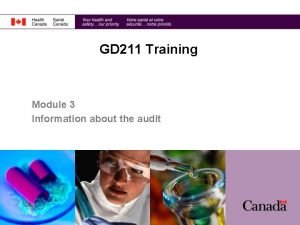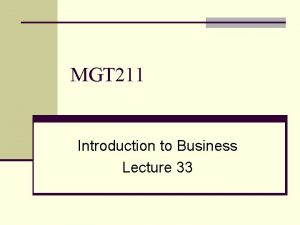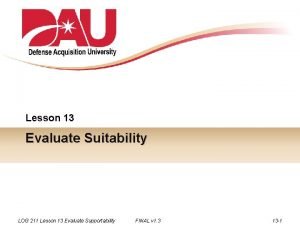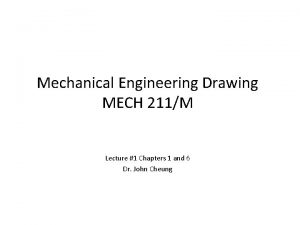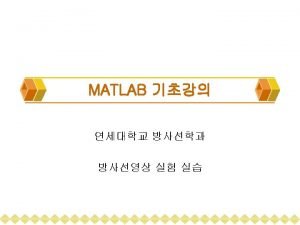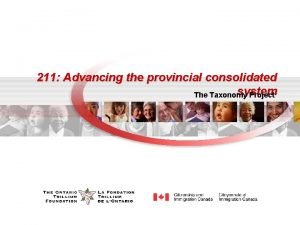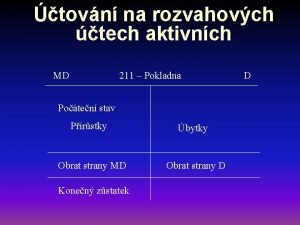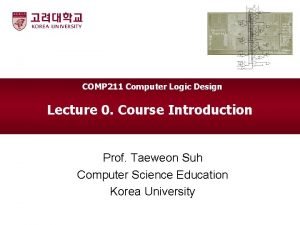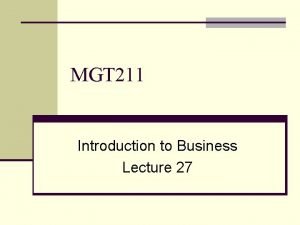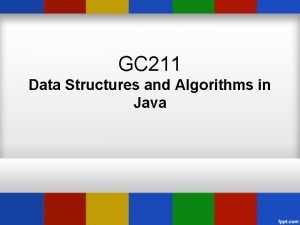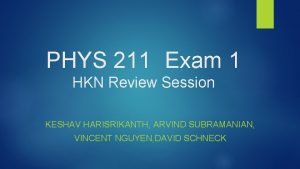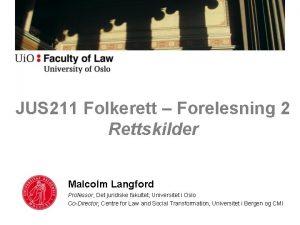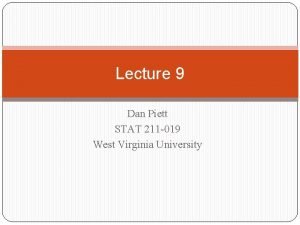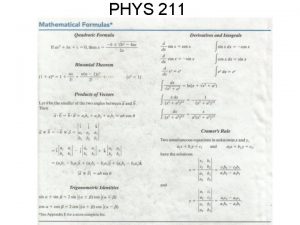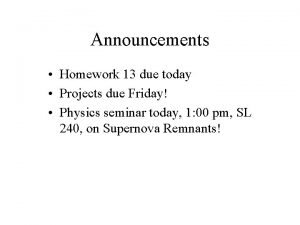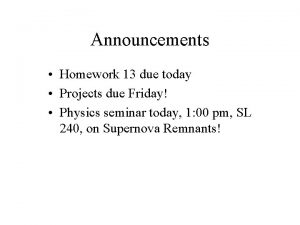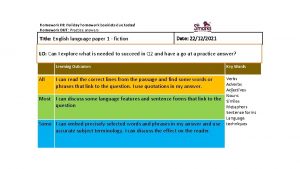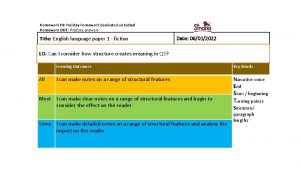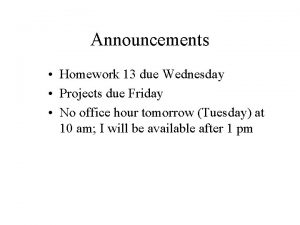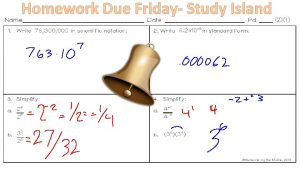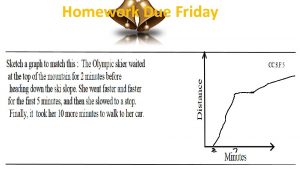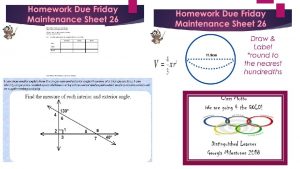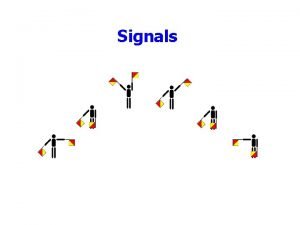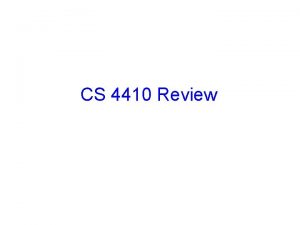Announcements Homework 2 Due 211 today at 11




































































- Slides: 68

Announcements § Homework 2 § Due 2/11 (today) at 11: 59 pm § Electronic HW 2 § Written HW 2 § Project 2 § Releases today § Due 2/22 at 4: 00 pm § Mini-contest 1 (optional) § Due 2/11 (today) at 11: 59 pm

CS 188: Artificial Intelligence How to Solve Markov Decision Processes Instructors: Sergey Levine and Stuart Russell University of California, Berkeley [slides adapted from Dan Klein and Pieter Abbeel http: //ai. berkeley. edu. ]

Example: Grid World § A maze-like problem § § The agent lives in a grid Walls block the agent’s path § Noisy movement: actions do not always go as planned § § § 80% of the time, the action North takes the agent North 10% of the time, North takes the agent West; 10% East If there is a wall in the direction the agent would have been taken, the agent stays put § The agent receives rewards each time step § § Small “living” reward each step (can be negative) Big rewards come at the end (good or bad) § Goal: maximize sum of (discounted) rewards

Recap: MDPs § Markov decision processes: § § § States S Actions A Transitions P(s’|s, a) (or T(s, a, s’)) Rewards R(s, a, s’) (and discount ) Start state s 0 § Quantities: § § s a s, a, s’ Policy = map of states to actions Utility = sum of discounted rewards Values = expected future utility from a state (max node) Q-Values = expected future utility from a q-state (chance node) s’

Example: Racing § § A robot car wants to travel far, quickly Three states: Cool, Warm, Overheated Two actions: Slow, Fast Going faster gets double reward 0. 5 +1 Fast +1 Slow 1. 0 -10 0. 5 Warm Slow Fast 1. 0 +1 Cool 0. 5 +2 Overheated

Racing Search Tree

Discounting § How to discount? § Each time we descend a level, we multiply in the discount once § Why discount? § Sooner rewards probably do have higher utility than later rewards § Also helps our algorithms converge § Example: discount of 0. 5 § U([1, 2, 3]) = 1*1 + 0. 5*2 + 0. 25*3 § U([1, 2, 3]) < U([3, 2, 1])

Optimal Quantities § The value (utility) of a state s: V*(s) = expected utility starting in s and acting optimally s s is a state a § The value (utility) of a q-state (s, a): Q*(s, a) = expected utility starting out having taken action a from state s and (thereafter) acting optimally (s, a) is a q-state s, a, s’ s’ (s, a, s’) is a transition § The optimal policy: *(s) = optimal action from state s [Demo: gridworld values (L 9 D 1)]

Solving MDPs

Snapshot of Demo – Gridworld V Values Noise = 0. 2 Discount = 0. 9 Living reward = 0

Snapshot of Demo – Gridworld Q Values Noise = 0. 2 Discount = 0. 9 Living reward = 0

Racing Search Tree

Racing Search Tree

Racing Search Tree § We’re doing way too much work with expectimax! § Problem: States are repeated § Idea: Only compute needed quantities once § Problem: Tree goes on forever § Idea: Do a depth-limited computation, but with increasing depths until change is small § Note: deep parts of the tree eventually don’t matter if γ < 1

Time-Limited Values § Key idea: time-limited values § Define Vk(s) to be the optimal value of s if the game ends in k more time steps § Equivalently, it’s what a depth-k expectimax would give from s [Demo – time-limited values (L 8 D 6)]

k=0 Noise = 0. 2 Discount = 0. 9 Living reward = 0

k=1 Noise = 0. 2 Discount = 0. 9 Living reward = 0

k=2 Noise = 0. 2 Discount = 0. 9 Living reward = 0

k=3 Noise = 0. 2 Discount = 0. 9 Living reward = 0

k=4 Noise = 0. 2 Discount = 0. 9 Living reward = 0

k=5 Noise = 0. 2 Discount = 0. 9 Living reward = 0

k=6 Noise = 0. 2 Discount = 0. 9 Living reward = 0

k=7 Noise = 0. 2 Discount = 0. 9 Living reward = 0

k=8 Noise = 0. 2 Discount = 0. 9 Living reward = 0

k=9 Noise = 0. 2 Discount = 0. 9 Living reward = 0

k=10 Noise = 0. 2 Discount = 0. 9 Living reward = 0

k=11 Noise = 0. 2 Discount = 0. 9 Living reward = 0

k=12 Noise = 0. 2 Discount = 0. 9 Living reward = 0

k=100 Noise = 0. 2 Discount = 0. 9 Living reward = 0

Computing Time-Limited Values

Value Iteration

Value Iteration § Start with V 0(s) = 0: no time steps left means an expected reward sum of zero § Given vector of Vk(s) values, do one step of expectimax from each state: Vk+1(s) a s, a § Repeat until convergence s, a, s’ Vk(s’) § Complexity of each iteration: O(S 2 A) § Theorem: will converge to unique optimal values § Basic idea: approximations get refined towards optimal values § Policy may converge long before values do

Example: Value Iteration 3. 5 2. 5 0 2 1 0 Assume no discount! 0 0 0

Convergence* § How do we know the Vk vectors are going to converge? § Case 1: If the tree has maximum depth M, then VM holds the actual untruncated values § Case 2: If the discount is less than 1 § Sketch: For any state Vk and Vk+1 can be viewed as depth k+1 expectimax results in nearly identical search trees § The difference is that on the bottom layer, Vk+1 has actual rewards while Vk has zeros § That last layer is at best all RMAX § It is at worst RMIN § But everything is discounted by γk that far out § So Vk and Vk+1 are at most γk max|R| different § So as k increases, the values converge

The Bellman Equations How to be optimal: Step 1: Take correct first action Step 2: Keep being optimal

The Bellman Equations § Definition of “optimal utility” via expectimax recurrence gives a simple one-step lookahead relationship amongst optimal utility values s a s, a, s’ s’ § These are the Bellman equations, and they characterize optimal values in a way we’ll use over and over

Value Iteration § Bellman equations characterize the optimal values: V(s) a s, a, s’ § Value iteration computes them: § Value iteration is just a fixed point solution method § … though the Vk vectors are also interpretable as time-limited values V(s’)

Policy Methods

Policy Evaluation

Fixed Policies Do the optimal action Do what says to do s s a (s) s, a s, (s) s, a, s’ s, (s), s’ s’ s’ § Expectimax trees max over all actions to compute the optimal values § If we fixed some policy (s), then the tree would be simpler – only one action per state § … though the tree’s value would depend on which policy we fixed

Utilities for a Fixed Policy § Another basic operation: compute the utility of a state s under a fixed (generally non-optimal) policy s (s) § Define the utility of a state s, under a fixed policy : s, (s) V (s) = expected total discounted rewards starting in s and following s, (s), s’ § Recursive relation (one-step look-ahead / Bellman equation): s’

Example: Policy Evaluation Always Go Right Always Go Forward

Example: Policy Evaluation Always Go Right Always Go Forward

Policy Evaluation § How do we calculate the V’s for a fixed policy ? s (s) § Idea 1: Turn recursive Bellman equations into updates (like value iteration) s, (s), s’ s’ Challenge question: how else can we solve this? § Efficiency: O(S 2) per iteration § Idea 2: Without the maxes, the Bellman equations are just a linear system § Solve with Matlab (or your favorite linear system solver)

Policy Extraction

Computing Actions from Values § Let’s imagine we have the optimal values V*(s) § How should we act? § It’s not obvious! § We need to do a mini-expectimax (one step) § This is called policy extraction, since it gets the policy implied by the values

Computing Actions from Q-Values § Let’s imagine we have the optimal q-values: § How should we act? § Completely trivial to decide! § Important lesson: actions are easier to select from q-values than values!

Policy Iteration

Problems with Value Iteration § Value iteration repeats the Bellman updates: s a s, a § Problem 1: It’s slow – O(S 2 A) per iteration s, a, s’ § Problem 2: The “max” at each state rarely changes § Problem 3: The policy often converges long before the values s’

k=0 Noise = 0. 2 Discount = 0. 9 Living reward = 0

k=1 Noise = 0. 2 Discount = 0. 9 Living reward = 0

k=2 Noise = 0. 2 Discount = 0. 9 Living reward = 0

k=3 Noise = 0. 2 Discount = 0. 9 Living reward = 0

k=4 Noise = 0. 2 Discount = 0. 9 Living reward = 0

k=5 Noise = 0. 2 Discount = 0. 9 Living reward = 0

k=6 Noise = 0. 2 Discount = 0. 9 Living reward = 0

k=7 Noise = 0. 2 Discount = 0. 9 Living reward = 0

k=8 Noise = 0. 2 Discount = 0. 9 Living reward = 0

k=9 Noise = 0. 2 Discount = 0. 9 Living reward = 0

k=10 Noise = 0. 2 Discount = 0. 9 Living reward = 0

k=11 Noise = 0. 2 Discount = 0. 9 Living reward = 0

k=12 Noise = 0. 2 Discount = 0. 9 Living reward = 0

k=100 Noise = 0. 2 Discount = 0. 9 Living reward = 0

Policy Iteration § Alternative approach for optimal values: § Step 1: Policy evaluation: calculate utilities for some fixed policy (not optimal utilities!) until convergence § Step 2: Policy improvement: update policy using one-step look-ahead with resulting converged (but not optimal!) utilities as future values § Repeat steps until policy converges § This is policy iteration § It’s still optimal! § Can converge (much) faster under some conditions

Policy Iteration § Evaluation: For fixed current policy , find values with policy evaluation: § Iterate until values converge: § Improvement: For fixed values, get a better policy using policy extraction § One-step look-ahead:

Comparison § Both value iteration and policy iteration compute the same thing (all optimal values) § In value iteration: § Every iteration updates both the values and (implicitly) the policy § We don’t track the policy, but taking the max over actions implicitly recomputes it § In policy iteration: § We do several passes that update utilities with fixed policy (each pass is fast because we consider only one action, not all of them) § After the policy is evaluated, a new policy is chosen (slow like a value iteration pass) § The new policy will be better (or we’re done) § Both are dynamic programs for solving MDPs

Summary: MDP Algorithms § So you want to…. § Compute optimal values: use value iteration or policy iteration § Compute values for a particular policy: use policy evaluation § Turn your values into a policy: use policy extraction (one-step lookahead) § These all look the same! § They basically are – they are all variations of Bellman updates § They all use one-step lookahead expectimax fragments § They differ only in whether we plug in a fixed policy or max over actions

Next Time: Reinforcement Learning!
 Homework due today
Homework due today Folk culture and popular culture venn diagram
Folk culture and popular culture venn diagram Homework due today
Homework due today Black cat analogy
Black cat analogy Homework due today
Homework due today Homework due today
Homework due today Homework due today
Homework due today Page 113 of fahrenheit 451
Page 113 of fahrenheit 451 Pvu market cap
Pvu market cap Potentiial
Potentiial /r/announcements
/r/announcements General announcements
General announcements David ritthaler
David ritthaler Parts of a poem
Parts of a poem Homework oh homework i hate you you stink
Homework oh homework i hate you you stink Homework oh homework jack prelutsky
Homework oh homework jack prelutsky Homework oh homework i hate you you stink
Homework oh homework i hate you you stink Homework oh homework
Homework oh homework Grant always turns in his homework
Grant always turns in his homework Did you finish your homework
Did you finish your homework Today meeting or today's meeting
Today meeting or today's meeting Fingerprint galton details
Fingerprint galton details For todays meeting
For todays meeting Today's lesson or today lesson
Today's lesson or today lesson Are you going to class today
Are you going to class today Today's lesson or today lesson
Today's lesson or today lesson Homework is due
Homework is due Homework is due on friday
Homework is due on friday Homework is due on friday
Homework is due on friday Homework due tomorrow
Homework due tomorrow Assignment due today
Assignment due today Reports due today!
Reports due today! Assignment due today
Assignment due today Blood supply of liver
Blood supply of liver Assignment due today
Assignment due today Astr 100 uiuc
Astr 100 uiuc Due piccole sfere identiche sono sospese a due punti
Due piccole sfere identiche sono sospese a due punti Quadrilateri con due lati paralleli
Quadrilateri con due lati paralleli Procedural vs substantive due process
Procedural vs substantive due process Slidetodoc. com
Slidetodoc. com Csce 211
Csce 211 Cu 211
Cu 211 Csce 211
Csce 211 Integument
Integument Mcb 211
Mcb 211 Economic 211
Economic 211 Comp 211
Comp 211 Gd 211
Gd 211 Poli 211
Poli 211 Mgt 211
Mgt 211 Asoe model
Asoe model Mech 211
Mech 211 Subplot 211 matlab
Subplot 211 matlab 211 taxonomy
211 taxonomy Csce 211
Csce 211 Opwekking 211
Opwekking 211 The prologue characters
The prologue characters Rupture cda
Rupture cda 211 pokladna
211 pokladna Comp 211
Comp 211 Consumer goods are purchased by mgt211
Consumer goods are purchased by mgt211 Gc 211
Gc 211 Physics 211 exam 1
Physics 211 exam 1 Jus 211
Jus 211 Point estimate of population mean
Point estimate of population mean Nur 211 final exam
Nur 211 final exam Gd 211
Gd 211 Trigo sy 120
Trigo sy 120 Physics 211
Physics 211


